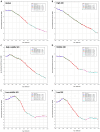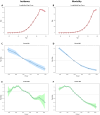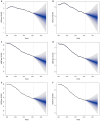Trends in the global, regional, and national burden of bladder cancer from 1990 to 2021: an observational study from the global burden of disease study 2021
- PMID: 40038504
- PMCID: PMC11880295
- DOI: 10.1038/s41598-025-92033-5
Trends in the global, regional, and national burden of bladder cancer from 1990 to 2021: an observational study from the global burden of disease study 2021
Abstract
To evaluate the changing trend and cross-country inequality of bladder cancer (BC) burden over the past 30 years and further predict the trend until 2036. Based on the Global Burden of Disease (GBD) 2021 study, the global incidence, mortality, and disability-adjusted life years (DALYs) of bladder cancer from 1990 to 2021 were obtained. We described the distribution of BC at global, regional and national levels and overall/local trends. The age-period-cohort analysis, decomposition analysis and inequality analysis related to socio-demographic index (SDI) were conducted. Additionally, we predicted the future trend of BC burden using Bayesian age-period-cohort model. In the GBD 2021, the global incidence number of BC was 540,310, doubling compared to that in 1990. However, the age-standardized rate (ASR) drops from 6.90 to 6.35. The changes in bladder cancer mortality and DALYs are similar. The ratio of ASRs of burden between males and females is approximately 4:1. Interestingly, in regions with middle SDI, low-middle SDI, and low SDI, the ASR of incidence has shown an upward trend to varying degrees in recent 10 years. Central Europe has the highest ASR of DALYs. China bore the heaviest burden of bladder cancer and experienced the greatest increase in the burden of bladder cancer. Globally, population growth, aging, and epidemiological changes accounted for 89.83%, 83.91%, and - 73.74% of the changes in DALYs respectively. The absolute inequality related to the SDI increases significantly. The slope index of inequality for DALYs increases from 79.84 to 115.60, and the concentration index slightly decreases to 0.26 in 2021. The prediction showed that the ASRs of the three indicators of bladder cancer would continue to decline from 2022 to 2036. Despite a downward trend in ASRs from 1990 to 2021, the global bladder cancer burden has generally increased with regional and country variations. The burden growth pattern driven by population growth and aging may potentially increase the burden number in the future. Burden is concentrated in high-SDI countries and there are signs indicating a shift towards lower-SDI countries. These findings highlighted challenges in BC prevention and management.
Keywords: Bladder cancer; Disability-adjusted life years; Epidemiology; Global burden of disease; Health inequality; Incidence; Mortality; Socio-demographic index; Urology.
© 2025. The Author(s).
Conflict of interest statement
Declarations. Ethics approval and consent to participate: Our research is based on and strictly adheres to the Guidelines for Accurate and Transparent Health Estimates Reporting (GATHER). No ethical approval and informed consent were necessary for this study, which utilized the GBD database—a publicly available dataset with anonymized participant data. Consent for publication: Not applicable. Competing interests: The authors declare no competing interests.
Figures








References
-
- Sung, H. et al. Global cancer statistics 2020: GLOBOCAN estimates of incidence and mortality worldwide for 36 cancers in 185 countries. Ca Cancer J. Clin.71 (3), 209–249. 10.3322/caac.21660 (2021). - PubMed
-
- Antoni, S. et al. Bladder cancer incidence and mortality: A global overview and recent trends. Eur. Urol.71 (1), 96–108. 10.1016/j.eururo.2016.06.010 (2017). - PubMed
-
- Lobo, N. et al. Epidemiology, screening, and prevention of bladder Cancer. Eur. Urol. Oncol.5 (6), 628–639. 10.1016/j.euo.2022.10.003 (2022). - PubMed
-
- van Hoogstraten, L. M. C. et al. Global trends in the epidemiology of bladder cancer: challenges for public health and clinical practice. Nat. Rev. Clin. Oncol.20 (5), 287–304. 10.1038/s41571-023-00744-3 (2023). - PubMed
Publication types
MeSH terms
Grants and funding
LinkOut - more resources
Full Text Sources
Medical
Miscellaneous

